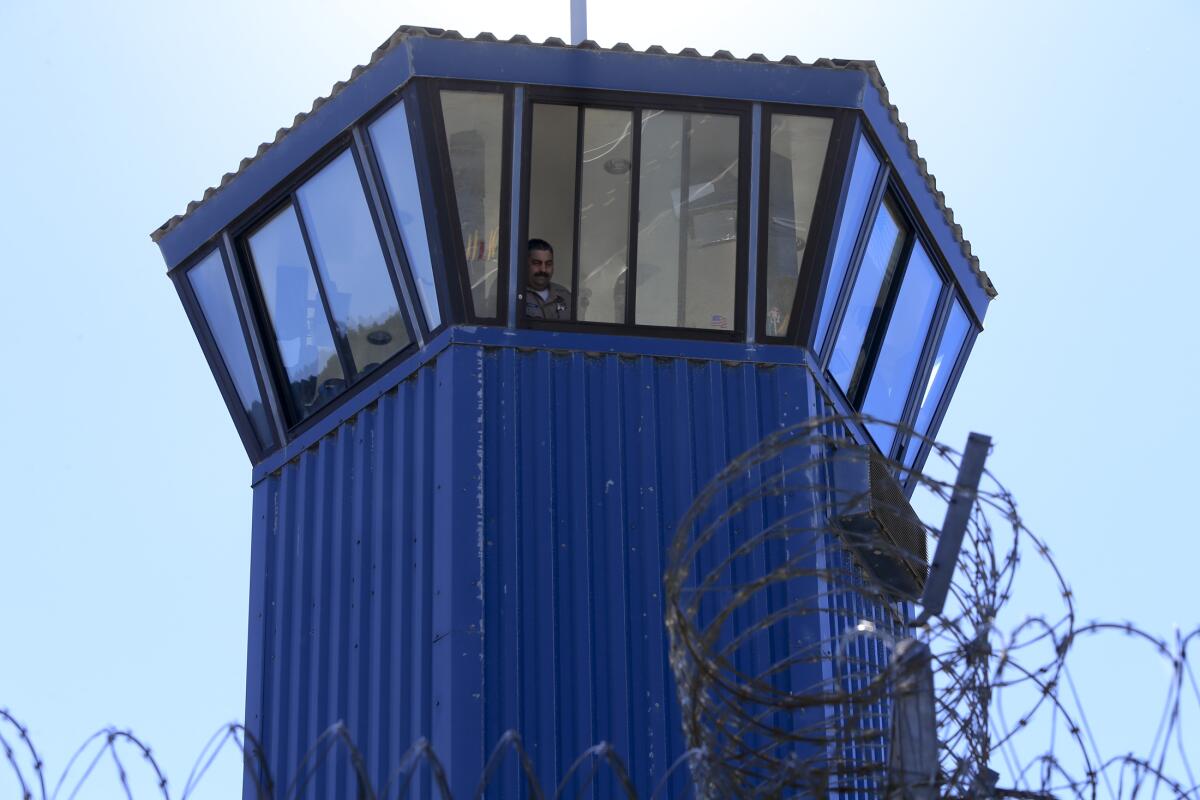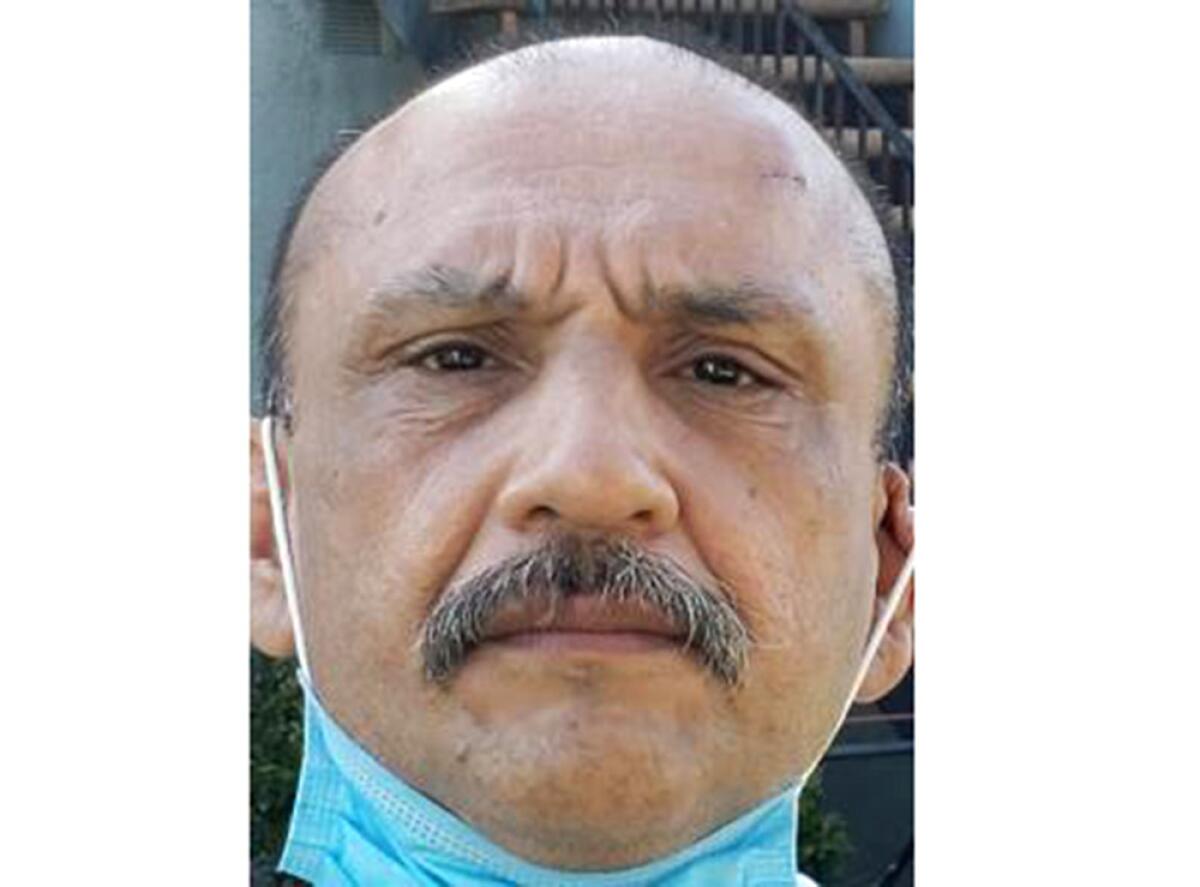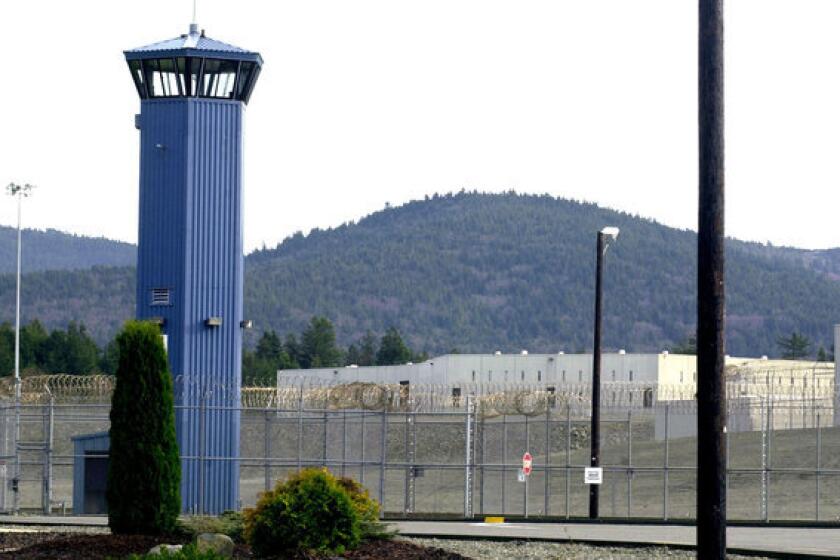He dodged a Mexican Mafia death sentence for 26 years. Then his luck ran out

It took 26 years for death to catch up to Donald Ramon Ortiz.
A member of the Mexican Mafia, Ortiz was cast out of the criminal organization in the mid-1990s after angering other members. Ortiz, they decided, should be killed. For the next quarter-century, as he cycled through county jails, state prisons and brief stints on the street, he wore a target on his back.
Ortiz knew he was a marked man. Authorities knew it too. Whenever they discovered a plot to kill Ortiz or he was attacked in prison, they’d offer to protect him. His answer was always the same: I can take care of myself.
Then, last month, a man walked up to Ortiz and fired a bullet into his head, leaving him to die in the street in Chino. He was 59 years old.
Ortiz’s rise and fall in the Mexican Mafia tells a larger story about a syndicate that, through a mix of ruthlessness and business savvy, came to dominate California’s prisons and many of its street gangs. The killing of Ortiz illustrates how slights and betrayals within its ranks — some perceived, others real — have driven many decisions made over the Mexican Mafia’s treacherous history. With most of its members in prison for life and having nothing but time to nurse old grudges, decisions reverberate through the decades, shadowing those, like Ortiz, who perhaps thought they could live beyond the organization’s reach or outlast its memory.
::
Ortiz, known on the street as “Little Man,” was 13 when he joined a local gang, the Whittier Varrio Locos, according to court records. His life as a criminal began even earlier. At 11, a probation report says, Ortiz and two companions whipped someone with a belt and ordered him to take them to his apartment, where they robbed him of an eight-track tape deck. Ortiz was arrested and declared a ward of the court.
The robbery was the first in a string of crimes Ortiz would commit as a juvenile, the probation report shows. He was caught inside a stolen Volkswagen inhaling solvent fumes to get high when he was 12. The following year, he and another boy robbed a woman of her purse at knifepoint. Eight months later, he and his friends refused to leave a Jack in the Box and brawled with the police officers who were called to the restaurant.
The allegation that a Glendale detective betrayed his associate and arranged a 2016 attack remains unproven.
At 19, Ortiz was convicted of manslaughter and served four years of a seven-year sentence. Following that stint behind bars, police found him carrying a gun and he was sent to the Los Angeles County Men’s Central Jail in 1986. It was there that Ortiz was given a job that would fast-track his rise in the Mexican Mafia and lay the groundwork for his downfall.
Danny “Kojak” Deavilla was a Mexican Mafia member from northeast Los Angeles, but he had fallen out of favor in the organization and narrowly survived a stabbing in prison a few years earlier. When Deavilla was booked into the jail, two Mexican Mafia members ordered Ortiz to kill him, according to a former member who spoke to The Times on condition of anonymity.

They handed Ortiz a kitchen knife stolen from the jail staff’s dining room.
Deavilla was stabbed to death and Ortiz reported back to the men who’d given him the order that he’d carried it out, the former member said. He was 23.
For killing Deavilla, Ortiz was welcomed into the Mexican Mafia, the former member said. Authorities confirmed he joined the group a few years later in 1989 while he was locked up in Pelican Bay State Prison, then a newly built maximum security facility about a dozen miles south of the Oregon border, according to records reviewed by The Times.
The Mexican Mafia was born in the California state prison system in the late 1950s. Latino gang members from Southern California banded together for protection against inmates of other races and Latino gangs from Northern California. They came to control the drug trade and other illicit business inside prisons, ordering attacks on inmates and prison staff who crossed them.
Federal authorities on Wednesday capped a sweeping investigation into the Mexican Mafia with criminal counts against dozens of the organization’s members and foot soldiers, saying the charges were a bid to disrupt the gang’s control inside Los Angeles County jails.
Over time, the Mexican Mafia leveraged this grip on the penal system into control over Latino street gangs in Southern California and the state’s Central Valley. The gangs must pay “taxes” — either a monthly flat fee or a percentage of their take from drug sales, robberies and other crimes. Those who refuse to pay are marked for assault or murder.
Authorities estimate there are only about 140 members of the Mexican Mafia. They rely on a network of associates, inside and outside prison, to collect taxes from gangs and drug dealers, relay messages and carry out beatings, stabbings and shootings.
::
In 1995, a dozen Mexican Mafia members gathered in a motel room in the San Gabriel Valley to talk business. Among the issues they discussed was Ortiz.
One of the men in the room was an informant, working for a team of FBI agents and L.A. County sheriff’s detectives who had rigged the room with hidden cameras. They listened and watched as the men accused Ortiz of “disrespecting” the Mexican Mafia and decided that he should die for the transgression, according to evidence presented at a racketeering trial a few years later.
Word had spread that Ortiz had lied about the slaying that earned him a place in the organization, the former member said. Instead of killing Deavilla himself, Ortiz had passed the knife to another inmate who went by the same nickname — Tommy “Little Man” Moreno from the Echo Park gang. After Moreno stabbed Deavilla to death, Ortiz took the credit, the former member said.
Samuel Villalba, a longtime member of the Mexican Mafia who had fallen out favor with the prison gang, was shot to death Sunday in Long Beach, according to the police and law enforcement sources.
Ortiz’s deceit became known when Moreno was charged with murdering Deavilla alongside Ortiz, the former member said. Court records show Moreno pleaded guilty to voluntary manslaughter and was sentenced to 11 years in prison. Ortiz, meanwhile, pleaded guilty to being only an accessory and was sentenced to two years, the records show.
“He got ‘made’ under false pretenses,” the former member said.
Ortiz had also angered Daniel “Cuate” Grajeda, the Mexican Mafia member who had vouched for him and sponsored his induction, the former member said. Grajeda had ordered an attack on Ortiz, believing his onetime protege had stolen a car and some drugs from him, according to the former member and another defector who spoke with Leo Duarte, a retired official from the California Department of Corrections and Rehabilitation who investigated the Mexican Mafia for decades.
Richard Valdemar, a retired L.A. County sheriff’s sergeant who investigated the plot to kill Ortiz, said the Mexican Mafia’s horizontal structure — in theory, every member is of equal stature — lends itself to the type of “politicking” that led to Ortiz’s ouster.
“Since there’s no hierarchy — there is no president or leader — if you don’t like somebody, you can start badmouthing him, and if you get a consensus, you can take that person out,” Valdemar said.
Killing Ortiz would be difficult. He was locked up in an L.A. County jail and authorities had moved him to a protective custody wing after monitoring Mexican Mafia meetings at which members discussed Ortiz’s mistakes.
One of the men in the motel room, David “Smilon” Gallardo, proposed a plan, records from his trial show. A Mexican Mafia associate facing criminal charges in L.A. County court would subpoena Ortiz as a witness. When Ortiz was brought to the courthouse and placed in a holding cell with other gang members, a Mexican Mafia camarada would kill him.
Jose Luis Loza of Whittier is sentenced after a trial that served as a window into arguably Southern California’s most powerful criminal organization.
The architects of the plot to kill Ortiz were arrested before it could be carried out. Convicted in federal court of murder, racketeering and other crimes, most were sentenced to life in prison.
Two years after the motel meeting, while Ortiz was back in custody for violating his parole, he was beaten and stabbed in the exercise yard at the state prison in Chino. Authorities suspected a Mexican Mafia member had ordered the attack, according to law enforcement records.
Ortiz brushed off appeals from authorities to renounce his underworld ties and accept their offers of protection, Valdemar recalled. “He would say, ‘If they want to come after me, they can.’ He had a lot of confidence in his ability to defend himself.”
Ortiz’s refusal to cooperate with law enforcement — to turn on an organization that had turned on him — earned a measure of begrudging respect from the sergeant. “I actually liked him,” Valdemar said, “because he had a lot of balls.”
::
Ortiz was back on the streets in 2001 when he made an impulsive decision that would return him to prison for another 13 years.
A Los Angeles County sheriff’s detective, targeting an area of Whittier that had suffered a rash of car thefts, parked a green 1998 Honda Accord in an alley. She left the doors unlocked and the keys in the ignition and walked away. Ortiz got into the car and drove off.
Video cameras hidden in the car captured Ortiz saying, “I’m stealing this motherf— car,” according to testimony at his trial. Detectives arrested Ortiz a short time later with the keys in his hand.
Duarte, who spoke with Ortiz after he was attacked in prison, said that although he had been expelled from the organization, Ortiz still considered himself a Mexican Mafia member, with all the authority that comes with it. Stealing a car was a stunningly low-level crime for him to commit. The following year, a jury found Ortiz guilty.
Federal prosecutors on Thursday charged Michael Lerma with ordering the murder of an inmate at the federal Metropolitan Detention Center in downtown Los Angeles.
Deputy Dist. Atty. Shelly Baron Torrealba urged the judge to send Ortiz to prison for as long as the law allowed. In a sentencing memo, she alleged that Ortiz was the “prime suspect” in three murders in the 1980s and ’90s that remained unsolved because witnesses would not cooperate.
One of the victims, Torrealba wrote, was a man who had previously fathered a child with Ortiz’s girlfriend. Another was a Mexican Mafia figure killed in Whittier. The third victim’s body had been found in Turnbull Canyon.
Ortiz’s attorney, Andrew Stein, called the prosecutor’s memo “character assassination.”
“I say to the people, put up or shut up, and I say that with great anger,” Stein said in court, according to a transcript of the hearing. Ortiz “is so stupid he steals a car in broad daylight on videotape,” Stein said, “but he is so smart he’s committed all these murders over the years that they can’t charge.”
Ortiz was sentenced to 13 years in state prison, plus another six years for possessing weapons in jail awaiting trial, according to court records and a spokesman for the state corrections department.
While Ortiz sat in prison, federal agents and police officers from Whittier were tapping the phone of Jose “Cartune” Loza, a recently paroled Mexican Mafia member who was operating in and around Whittier in territory that Ortiz had once controlled.
Peter “Chavo” Orozco, a member of a local gang, asked Loza if he knew someone called “Jimbo” and speculated he might be collecting taxes on behalf of Ortiz, according to an affidavit written by a Homeland Security Investigations agent supervising the wiretap. Loza said he had never heard of him.
If “Jimbo” was in fact collecting money for Ortiz, Orozco said he would “beat the f— out of him” and “shoot that motherf— on sight,” according to the agent’s affidavit.
Because Ortiz had “fallen out of graces” with the Mexican Mafia, the agent wrote, “anyone claiming to collect on his behalf” would likely be assaulted.
After Ortiz was released from prison in 2019, he was rumored to have been trying to operate in Chino, a city of about 90,000 people on the western edge of San Bernardino County, according to a law enforcement official who wasn’t authorized to discuss the matter and requested anonymity.
In October 2019, Ortiz and two other men were arrested in Chino and charged with robbing a man of a pistol, court records show. Ortiz pleaded guilty to grand theft and was sentenced to a year and four months in county jail.
Six months after he was released, Ortiz was arrested again, this time for being drunk in public. In a police report, his address was listed as a second-story apartment in the 5100 block of Philadelphia Street.
On Nov. 19, police were called to that block at 4:31 p.m. Ortiz was dead by the time they got there. His body lay in the street — just the third person killed this year in Chino.
A witness told police that a man with a thin build, about 5 feet 9 inches tall and wearing a blue suit jacket, exchanged a few words with Ortiz before shooting him once in the head with a handgun, said Sgt. Jesus Jacquez of the Chino Police Department. The suspect was last seen walking south through an apartment complex, Jacquez said.
After the shooting, police locked down an elementary school across the street and set up a perimeter, but the shooter eluded the dragnet. He remains at large and should be considered armed and dangerous, Jacquez said.
It is often difficult for former members of the Mexican Mafia to accept that they’ve lost that authority and must live as “John Doe citizen,” said Ramon “Mundo” Mendoza, who defected from the organization in the 1970s.
“This is their identity,” he said. “This is their status. They’re somebody.”
“But if you’re in denial because you don’t want to surrender your identity, your status, you’re committing suicide,” Mendoza said. “When you’re deemed ‘no good’ by the Mexican Mafia, there’s no rehabilitation. There’s no coming back from that.”
More to Read
Sign up for Essential California
The most important California stories and recommendations in your inbox every morning.
You may occasionally receive promotional content from the Los Angeles Times.











